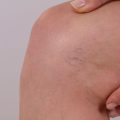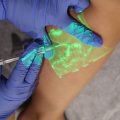Search a topic
Last updated on September 2, 2024
Looking to get laser spider vein removal? It’s important to know your options, their effectiveness, and their potential risks to make an informed decision. So, we’ve compiled everything you need to know about all currently available spider vein laser treatments.
What does laser spider vein removal involve?
Most spider vein laser treatments are topical, meaning you won’t need any incisions or injections. The lasers’ heat targets problem blood vessels through the skin, sealing them up for your body to absorb over time. For larger spider veins, a specialist might use endovenous laser therapy, where they feed a laser fibre into the vein through a small cut to heat and seal it. For topical lasers, specialists generally use a cooling system to protect the skin. Meanwhile, you may need regional anaesthesia for endovenous treatment.
Argon Laser for facial spider veins
Argon lasers were the first lasers specialists used to treat spider veins. They have a relatively short blue-green wavelength of 488-514, giving them a very high haemoglobin absorption rate and letting them target small veins ~1 mm under the skin. Like all cutaneous (topical/transdermal) lasers, Argon lasers heat problem vessels, causing them to clot and seal off from the rest of the body, Over time, your body will reroute blood flow to healthy veins and arteries and absorb the treated one.
These lasers are therefore best suited for facial spider veins, which are generally smaller and more superficial.
While argon lasers are effective for tiny spider veins close to the skin’s surface, they do have some drawbacks. First, your skin has a lot of blood vessels. So, the laser’s excellent absorption rate means it can’t target deeper spider veins. Second, its absorption rate also makes it more likely to cause scarring and pigmentation.
Pulsed Dye Laser for surface veins
Pulsed Dye Lasers are frequently used to remove birthmarks and stretch marks. They can also seal up spider veins, as their 594 nm wavelength lets them bypass skin to target problem blood vessels. However, as their wavelength is still relatively short, they are less effective for larger and deeper veins.
Generally, these lasers carry less risk of pigmentation and scarring than Argon lasers. However, they can cause discolouration (hypo and hyperpigmentation) in people with darker skin tones.
Pulsed dye laser procedures are generally well-tolerated, with patients describing them as feeling like the snap of a rubber band. After treatment, you may experience some redness and swelling as you would with laser hair removal – though this is true of all cutaneous laser treatments. You can manage these side effects with cooling creams and by avoiding strenuous exercise for 3-5 days and hot showers for 24 hours.
Pulsed Diode Laser for spider veins on the legs
Pulsed diode lasers have a wavelength of 800-900nm, letting them target larger, deeper vessels and making them suitable for leg veins. These lasers are also well-tolerated and carry less risk of adverse effects like scarring and burns because they’re attached to a cooling device and have shorter pulses.
There is still some risk of scarring, with one study finding 2 out of 35 patients developing indented scars.
Nd:YAG
Nd:YAG lasers have a longer wavelength of 1064nm, making them suitable for larger-calibre veins. They are some of the best lasers for spider veins in the legs.
However, Nd:YAG lasers can be less comfortable than others and can cause hyperpigmentation. To ensure your comfort, we use a cooling device during treatment – it will feel similar to laser hair removal. To minimise the risk of hyperpigmentation, we recommend not exposing the area to sunlight for 2 weeks before and 2 weeks after treatment.
Potassium-titanyl Phosphate
Potassium-titanyl-phosphate (KTP) lasers pass their laser beam through a KTP crystal, doubling the frequency of Nd:YAG lasers. The higher frequency makes them suitable for darker skin tones and smaller vessels. This laser type is typically limited to facial vein treatments, however, as they have limited penetration and therefore aren’t as effective for leg veins
Endovenous Laser
Endovenous lasers are rare to see in spider vein treatments. As spider veins are small venules and capillaries, a laser fibre cannot manoeuvre through most of them. For most spider veins that are too large for a topical laser, specialists opt for sclerotherapy.
Generally, EVLA is a safe and effective treatment – predominantly used for varicose veins. It does carry some risks and side effects, like aches and swelling post-procedure and a >0.1% risk of a blood clot or nerve damage.
Laser spider vein removal: the takeaway
When it comes to lasers for spider veins, there are a lot of options. These are designed to heat the problem vessels either externally through the skin or internally through the vein. Once sealed, your body will absorb the vein. Generally, the best option for you depends on where the veins are and their size. In some cases, your specialist may recommend sclerotherapy instead.





